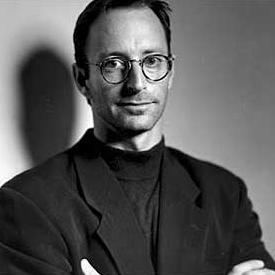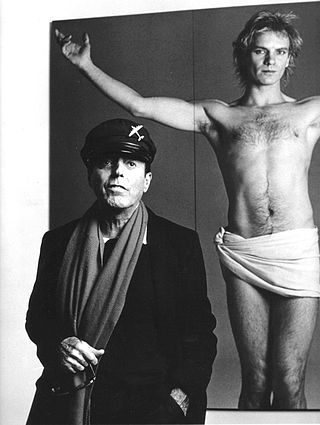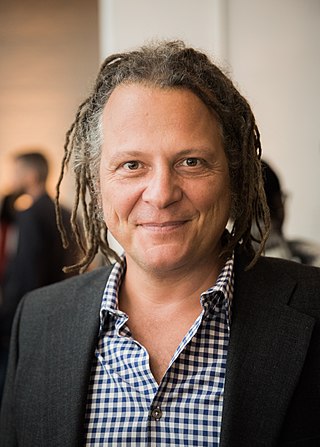Chris Buck | |
|---|---|
 Chris Buck holding preview copy of his second book, "Uneasy," December 21, 2016 |
Chris Buck (born July 29, 1964) is a New York-based photographer known for his unconventional portraits.
Chris Buck | |
|---|---|
 Chris Buck holding preview copy of his second book, "Uneasy," December 21, 2016 |
Chris Buck (born July 29, 1964) is a New York-based photographer known for his unconventional portraits.
Buck grew up in the Toronto suburb of Etobicoke where his father, George Buck worked for Kodak Canada, giving him an early connection to photography. [1] He attended Ryerson University where he majored in Photographic Arts. During this time he was a photo editor for Nerve, a Toronto monthly music paper, released 3 compilation cassettes of original music with Canadian and American bands with Materials + Processes, and briefly managed experimental rock group Violence & The Sacred. [2] [3] Buck studied at Ryerson under noted street photographer Dave Heath and media critic Murray Pomerance, both of whom continued as mentors in the years after his graduation. He moved to New York in 1990 and has since shot many important magazine and advertising photographs. [4]
Buck's move to New York in 1990 focused on magazine portrait work, and began a slow progression in the prominence of his celebrity sitters and the stature of his clients. His photography is currently most associated with GQ , Esquire , The Guardian Saturday, and The New York Times Magazine .
Since the late 1990s Buck has photographed a number of commercial campaigns, for Coca-Cola, Google, Microsoft, Kia, Mazda, Old Spice, and TD Bank.
His most recognized portraits include those of Steve Martin, Chris Farley, Margaret Atwood, Willie Nelson, Eminem, and Jay-Z. Buck has also photographed many American politicians, including Presidents Barack Obama, George H. W. Bush, George W. Bush and Donald Trump. [5] Buck has directed several videos for clients, such as GQ , Wired, SAP SE, Oscar Mayer, and Viagra. [6]
In the spring and summer of 2015 Buck chronicled the adventures and eventual demise of a 3D figurine of himself. The series, called Likeness, included 141 photos and videos released daily on his Instagram account. 56 of the images were included in a limited edition artist book of the series. [7] [8]
In the spring of 2010, photos he took for a Diesel ad campaign that encouraged consumers to "Be Stupid" led to some public outcry and heated editorials. Some ads were banned in the UK. The campaign won the Grand Prix for outdoor at the Cannes Lions International Festival of Creativity. [9] [10] [11]
In August 2011 Buck became the center of a controversy when his Newsweek cover photo of presidential candidate Michele Bachmann caused a media stir. [12] The photo even spawned a hate page titled "Meet Chris Buck, the a-hole who took the Michele Bachmann Newsweek photo." [13] The image prompted a comment from Sarah Palin and spawned several internet memes. [14] [15]
The May 2017 O, The Oprah Magazine focused on race in America, featuring Chris Buck's pictures depicting a flip of societal roles. The viral photos led to interviews with Buck in the Huffington Post, [16] CNN, [17] and Mic.com. [18]
In 2012 Buck's first monograph, Presence: The Invisible Portrait was released by German publisher Kehrer Verlag. Presence features 50 portraits in which the celebrity subjects are fully hiding, and therefore are not visible in the photographs. [19] The book garnered press coverage worldwide, as well as receiving some awards. [20]
In early 2017 Buck published Uneasy: Chris Buck Portraits 1986-2016, a monograph of his celebrity pictures, with 338 portraits and 129 stories behind the pictures. There is also an introduction by Sheila Heti. Press attention included GQ , People , CBC and New York magazine. [21] [22] [23] [24]
In 2021, Buck published Gentlemen's Club: Partners of Exotic Dancers, a collection of forty photo sittings and interviews exploring the relationships of these workers. The book received press coverage from The New Yorker , The New York Times and Refinery29 . [25] [26] [27]
His awards include the Arnold Newman Prize for his portraiture, [28] Ryerson University's Visionary Award (wall of fame at The Creative School), PDN's Notable Books 2012 and German Book Award 2013 Selected Title for his book Presence, and Luerzer's Archive 200 Best Ad Photographers (2012/2013 and 2014/2015). His work has appeared in: American Photography (50 times), Photo District News Photo Annual (22 times), and the Communication Arts Photography Annual (13 times). [29]
His solo shows include:

Herbert Ritts Jr. was an American fashion photographer and director known for his photographs of celebrities, models, and other cultural figures throughout the 1980s and 1990s. His work concentrated on black and white photography and portraits, often in the style of classical Greek sculpture, which emphasized the human shape.

David Royston Bailey is an English photographer and director, most widely known for his fashion photography and portraiture, and role in shaping the image of the Swinging Sixties.

Newsweek is an American weekly news magazine. It is co-owned by Dev Pragad, its president and CEO, and Johnathan Davis, who has no operational role; each owning 50%. Founded as a weekly print magazine in 1933, it was widely distributed during the 20th century, and had many notable editors-in-chief. The magazine was acquired by The Washington Post Company in 1961, and remained under its ownership until 2010.

Francesco Scavullo was an American fashion photographer best known for his work on the covers of Cosmopolitan and his celebrity portraits.

Vibe is an American music and entertainment magazine founded by producers David Salzman and Quincy Jones. The publication predominantly features R&B and hip hop music artists, actors and other entertainers. After shutting down production in the summer of 2009, it was purchased by the private equity investment fund InterMedia Partners, then issued bi-monthly with double covers and a larger online presence. The magazine's target demographic is predominantly young, urban followers of hip hop culture. In 2014, the magazine discontinued its print version.

Mario Eduardo Testino Silva OBE HonFRPS is a Peruvian fashion and portrait photographer.

Kevin P. Coughlin is a photojournalist, writer, governmental photographer, pilot, and aerial cinematographer. He is the former executive photographer to New York Governor Kathy Hochul and to New York's previous Governor Andrew M. Cuomo. His photographs at Ground Zero following the September 11, 2001 attacks on the World Trade Center and while covering funerals and memorial services of fallen fire fighters, police officers, and emergency personnel killed as a result of the attacks are included in the 2002 Pulitzer Prize awarded to The New York Times for Public Service. In addition to The New York Times, his photographs have appeared in the New York Post, New York Daily News, Newsday, The Philadelphia Inquirer, The Los Angeles Times, Bloomberg News, Business Week, People, Sports Illustrated, Rolling Stone, Time, USA Today and The Wall Street Journal. He has also written magazine articles for GQ and News Photographer.

Jerry Avenaim is an American photographer best known for his fashion and celebrity images.

Martin Schoeller is a New York-based photographer whose style of "hyper-detailed close ups" is distinguished by similar treatment of all subjects whether they are celebrities or unknown. His most recognizable work are his portraits, shot with similar lighting, backdrop, and tone. His work appears in "National Geographic Magazine", The New Yorker, "New York Times Magazine", Time, GQ, and Vogue. He has been a staff photographer at The New Yorker since 1999.

Jason Bell is an English portrait and fashion photographer. He studied politics, philosophy and economics at Oxford University before returning to London to work for the Sunday Times. He lives in both New York and London. He describes photography as 'always part of who I was' and he sees himself as a portrait photographer rather than a fashion photographer, saying: 'for me the most important thing is the person'.
Ari Marcopoulos is an American self-taught photographer, adventurer and film artist. Born in the Netherlands, he is best known for presenting work showcasing elusive subcultures, including artists, snowboarders and musicians. He lives and works in New York. Marcopoulos is represented by Fergus McCaffery in New York and Tokyo, and Galerie Frank Elbaz in Paris.

The 2012 presidential campaign of Michele Bachmann, Congresswoman of Minnesota, began in June 2011. She ran for the 2012 Republican Party nomination for president of the United States. Bachmann announced she was running for president during the CNN Republican primary debate held June 13, 2011, and made her formal announcement two weeks later in her hometown of Waterloo, Iowa.
Eric Ogden is an American photographer, artist and director.
Brooke Shaden is an American fine art photographer.

Orange Prince(1984) is a painting by American artist Andy Warhol, of Prince, the American singer, songwriter, record producer, multi-instrumentalist, actor, and director. The painting is one of twelve silkscreen portraits on canvas of Prince created by Warhol in 1984, based on an original photograph provided to Warhol by Vanity Fair. The photograph was taken by Lynn Goldsmith. These paintings and four additional works on paper are collectively known as the Prince Series. Each painting is unique and can be distinguished by colour.
Mark Abrahams is an American fashion and portrait photographer whose work has been featured in Bazaar, Glamour, GQ, The New York Times Magazine, V, Vanity Fair, and Vogue. He has created powerful portraits of high profile celebrities in raw, black and white detail.

Markus Klinko is an international fashion/celebrity photographer. and director,

Ethan James Green is an American photographer, filmmaker, and director.

Gilbert Asante is a Ghanaian creative director, photographer, and a multidisciplinary artist. He is best known for his viral images of Ghanaian celebrities including Joselyn Dumas, Boxing legend Azumah Nelson, Lydia Forson, Big Brother Nigeria Housemate, Nengi.

In the December 2020 issue of American Vogue, English singer Harry Styles wore a custom-made blue Gucci dress as their first ever solo male cover star. Designed by head of Gucci Alessandro Michele, the dress received reactions from both conservative and progressive critics. Conservatives condemned the perceived corruption of traditional masculinity. Progressive critics gave mixed reactions, and the dress generated a significant amount of conversation about sexuality, gender roles, race, and privilege.
{{cite web}}: CS1 maint: url-status (link)